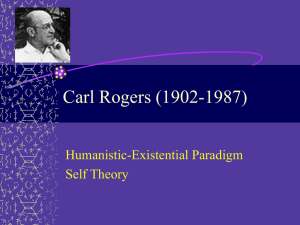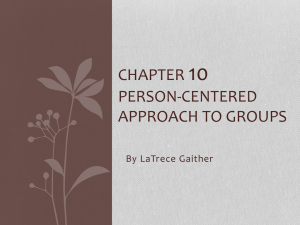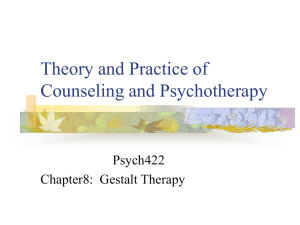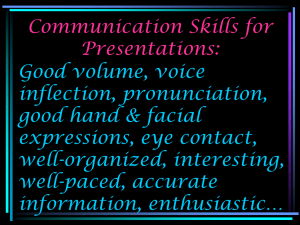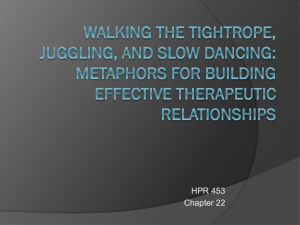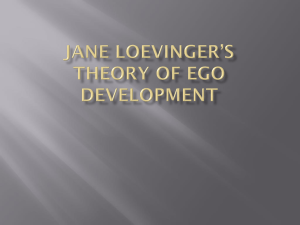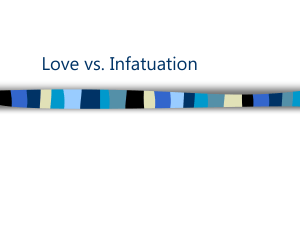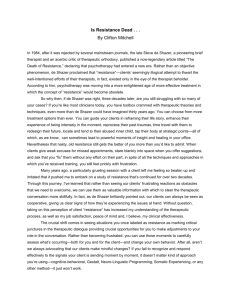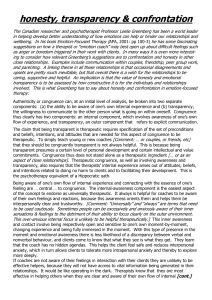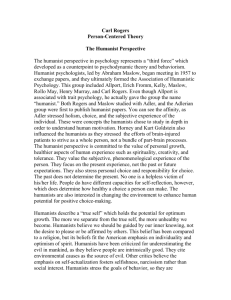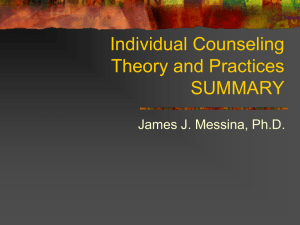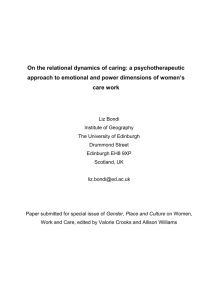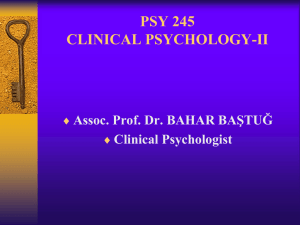File
advertisement
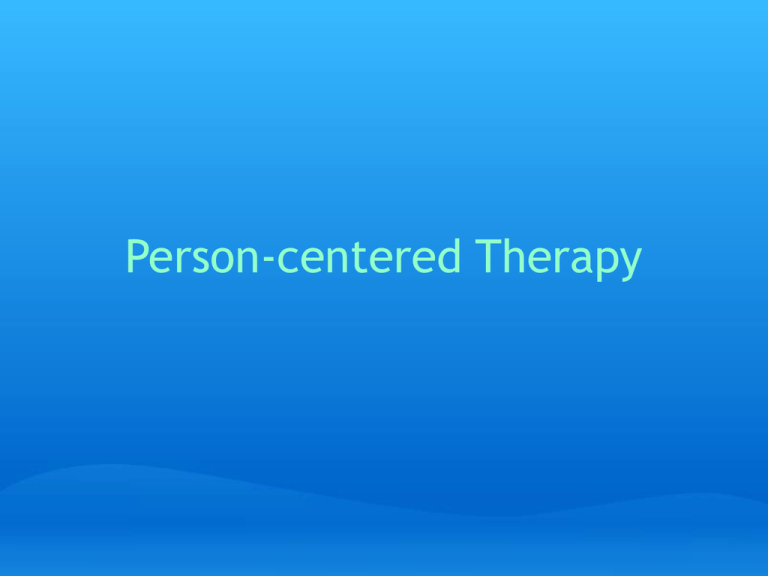
Person-centered Therapy Intro * based on concepts from humanistic psychology * Carl Rogers is identified as the most influential psychotherapist * shares many concepts and values with the existential perspective Development of the Approach 1st period (1940s) Rogers developed nondirective counseling - emphasized the counselor's creation of a permissive and non-directive climate - focused on reflecting and clarifying the client's verbal and non-verbal communications with the aim of helping clients become aware of and gain insight into their feelings. Development cont'd 2nd period (1950s) Rogers renamed it clientcentered therapy - characterized by a shift from clarification of feelings to a focus on the phenomenological world of the client - focused on actualizing tendency Development cont'd 3rd period (late 1950's - 1970s) Rogers conducted researches on the client-centered approach processes and outcomes - based on the findings of these researches the approach was further refined and expanded; aplied to eduaction (student-centered teaching) and encounter groups 4th period (1980s-1990s) considerable expansion to education, industry, groups, conflict resolution, and search for world peace - became known as person=centered approach Key concepts VIEW OF HUMAN NATURE > people are trustworthy, resourceful, capable of selfunderstanding and self-direction, able to make constructive changes, and able to live effective and productive lives three therapeutic core conditions that create that create a growth-promoting climate: 1. congruence (genuineness or realness) 2. unconditional positive regard (acceptance and caring) 3. accurate empathic understanding (an ability to deeply grasp the subjective world of another person) View of HN cont'd Human beings are essentially forward-moving organisms drawn to the fulfillment of their own creative natures and to the pursuit of truth and social responsiveness. *Actualizing tendency - a directional process of striving toward realization, fulfillment, autonomy, self-determination, and perfection. The Therapeutic Process THERAPEUTIC GOALS > achieve a greater degree of independence and integration by: > focuson the person, not on the person's presenting problems > assist clients in their growth process so clients could better cope with their current and future problems > to provide a climate conducive to helping individual become a fully functioning person cont'd Rogers (1961) described people who are becoming increasingly actualized as having: 1. 2. 3. 4. an openness to experience a trust in themselves an internal source of evaluation, and a willingness to continue growing * encouraging these chracteristics is the basic goal of the PCT Therapist's functions and roles > rooted in being and attitudes, not in techniques designed to get the client to "do something" > therapist use themselves as the instrument of change > to be present and accessible to clients and to focus on their immediate experience > PCT do not take a history, they avoid asking leading and probing questions, they do not make interpretations of the client's behavior, they do not evaluate a client's ideas or plans, and they do not decide for the client about the frequency or length of the therapeutic venture Client's experience in PCT clients come to the PCTist in a state of congruence > clients are able to explore a wider range of beliefs and feelings > with PCT, client distort less and move to a greater acceptance and integration of conflicting and confusing feelings.they increasingly discover aspects within themselves that have been kept hidden. > PCT allow them to experience freedom to be who they are > cont'd >with increased freedom, they become more mature psychologically and more actualized. >the therapy relationship experienced in PCT provides a supportive structure within which client's self-healing capacities are activated Relationship bet. Therapist and Client 1. two persons are in psychological contact. 2. the first person (the client) is in a state of incongruence, being vulnerable or anxious. 3. the second person (the therapist) is congruent (real or genuine) in the relationship. 4. the T experiences UPR for the client. 5. the T experiences EU of the client's internal frame of reference and endeavors to communicate this experience to the client. 6. the comunication to the CL of the therapist's EU and UPR is to a minimal degree achieved. cont'd Rogers - If the therapeutic core conditions exist over some period of time, construtive personality change will occur. The core conditions do not vary according to client type. They are necessary and sufficient for therapeutic change to occur. cont'd This approach is best described as a way of being and as a shared journey in which T and C reveal their humanness and participate in growth experience. CONGRUENCE or GENUINENESS - implies that therapists are real, that is, genuine, integrated, and authntic during the therapy hour. UNCONDITIONAL POSITIVE REGARD - deep and genuine caring for the client as a person cont'd ACCURATE EMPATHIC UNDERSTANDING - to understand the clients' experience and feelings sensitively and accurately as they are revealed in the therapy session. empathy - deep and subjective understanding of the client with the client. AEU- implies that the therapist will sense the client's feelings as if they were his or her own without becoming lost in those feelings. Application: Therapeutic Techniques and Procedures Emphasis on reflection of feelings - grasping the world of the client and reflecting this understanding. The use of Person-centered methods - the quality of the therapeutic relatonship, as opposed to the techniquesm is the primary agent of growth in the client. > experiencing and communicating attitudes - the process of "being with" clients and entering their world of perceptions and feelings > qualities such as skills in listening, accepting, respecting, understanding, and responding cont'd Immediacy - addressing what is going on between CL and TH The role of Assessment - emphasizes not on how the TH assesses the CL, but on the CL's self-assessment cont'd PCT is especially applicable in crisis intervention such as unwanted pregnancy, an illness, a disastrous event, or the loss of a loved one. It is also applicable to clients with anxiety disorders, alcoholism, psychosomatic problems, agoraphobia, interpersonal difficulties, depression, cancer, and personality disorders. P-C expressive arts therapy - offer clients the opportunity to create movement, visual art, journal writing, sound, and music to express their feelings and gain insight from these activities.
